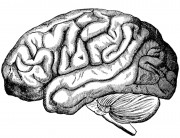Our brains are wired to look for the negative. Why is this? Stated simply, it’s about survival. Think about it: if you lived in the jungle and on your way home at the end of the day, if you didn’t stop to notice the pretty flowers, would it endanger you? No. But, if you didn’t notice the poisonous snake or the scary tiger or the cave-to-cave salesman, then you might actually be in danger. Thus, it is advantageous to our survival to keep an eye out for negative, unsafe, dangerous things.

However, we don’t live in the jungle anymore and the threats to our survival aren’t quite as literal anymore. We haven’t yet gotten rid of this natural instinct however; it has just transferred to other threats, social threats. We look for signs of rejection, exclusion, not belonging, not measuring up, etc. We do so because belonging to the group equals safety. Or at least it used to; that’s another fossil from our pre-industrialized past. With the development of cities and technology, a man can actually be an island and survive. I’m not saying he will be the happiest man, but he will be alive.
So, how do we overcome this natural tendency to be negative, pessimistic, and expect the worst? By putting in deliberate work to counteract it. The internet is full of click-bait articles with titles like “25 ways to change your thinking instantly!” These lists are accurate but not in the way they think they are. Instantaneous does describe how your thinking will change but rather than describing the speed of change, it describes the longevity of that change. Your thinking isn’t changed in an instant, it’s changed for an instant.
If you want to change your thinking on a more permanent basis, it requires constant maintenance, like a vegetable garden. A bountiful garden requires watering, feeding, and weeding, along with cooperation from the elements. Your thinking is no different. Thinking and learning are biological processes that take place within the billions of cells in your brain. Learning is the process of connecting those cells together in ways that they have never been organized before. If that new way of organizing the cells is repeated, the connections become strengthened and automatic over time. The key part of that phrase is “Over time”.
So, if you want to drown out the stream of negativity, why not give this a try:
Every day, make a list of 5 positive things that happened, either things that happened to you or things that you, yourself were responsible for. Don’t bother making a list of negative things or things you need to work on, your brain is doing that already. Your brain will try to cancel out these positives by pointing out a negative aspect of each of them but try to end on a positive for each one. For example, “today I got to work on time.” Your brain will probably counter with something helpful like “Yeah, for the first time this week”. Don’t leave it at that, but provide your own counter, such as “True, but obviously I do have the ability to do it”.
It’s pretty simple. Take the time every day to make a list of 5 positives and you will find yourself paying more attention to positive throughout the day, which will make it increasingly difficult to make the list, as you’ll have more than five to choose from.



















































[…] Fighting Back Against Negativity – by Ted Leavitt […]
again – Thank you for this helpful article. Thank you for taking the time to want to help us through media!! Thank you for spending YOUR precious time on me!!! I am definitely starting my 5 a day “journey” right now!!!!!!
Elna ~ South Africa